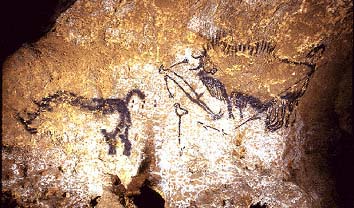"The shaman acts as intermediary between the world of men and the gods, and has the power to descend into the realms of the dead. His spirit is believed to journey forth from his body, which remains in a state of trance. Sometime the long journey which it takes is described by him in a chant. Sometimes he induces the conditions of ecstasy by beating his drum or by an elaborate and exciting dance" (118).

The cave painting above depicts a human figure with a bird head lying (flying?) beside a bison. This figure is traditionally called "the dead man," but he could just as easily depict a shaman who has fallen into a halucinatory trance. Notice the figure's erect phallus (indicating power, fertility?) and the bird (indicating flight to other worlds?) on a staff below him. Note, too, that while the bison appears to be charging, he has also been pierced by a spear in the groin area and is partially eviscerated. At the left is a fleeing rhinoceros. From the cave of Lascaux, France, 17,000 BC. [Use "Go" button to return to this page.]